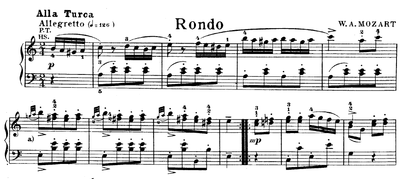Piano Sonata No. 11 (Mozart)

The Sonata no. 11 in A major , K. 331 (300i) is one of the most famous piano sonatas of Wolfgang Amadeus Mozart . Mozart wrote it in Vienna in 1783/84 . The first print appeared in 1784 at Artaria & Co.
The work was able to gain popularity particularly through its third movement ; this is one as Turkish March has become known and Alla Turca overridden Allegretto in rondo form in A Minor , which in A Major ends.
After the third, the first movement of the sonata is also often quoted in popular culture, and is valued by piano students for its catchy melody and simplicity.
Structure and analysis
The sonata consists of the following three movements:
- Theme. Andante grazioso - theme with variations I-VI
- Menuetto - minuet and trio
- Alla Turca. Allegretto - Rondo "Alla Turca"
A performance lasts approximately 26 minutes.
First sentence
The sonata begins with a variation movement instead of a sonata main movement . It consists of a theme with six variations.
theme
Andante grazioso, 6/8 time , A major
The theme is in two parts, each part being repeated once, and has characteristics of a Sicilian ; the rhythm of this baroque dance form pervades the whole piece and gives it its special, quite lovely character. The pace is kept calm and except for short passages signed with forte , which look more like accents , the same goes for the dynamics . The harmonics are also designed simply, as they hardly leave the main functions .
Variations
The composer avails himself of various possibilities to take up and process the theme in other ways: In addition to using complementary rhythms, changes are also made to the tone type , tempo and time signature.
Second sentence
Menuetto, 3/4 time, A major
The second movement is a minuet with the following sequence: Menuetto - Trio - Menuetto ( Da capo ) .
Menuetto
The minuet is made up of two parts, each of which is repeated. The first, 18-bar section initially underlines the typical stride of a minuet, but then modulates to the dominant E major , while rapid sixteenth -note movements show a contrast to the previous motifs . The second, 30-bar part begins with a kind of implementation in minor, which eventually ends up again in E Major, so that the first part as a recapitulation can be linked thereto; this ends in the tonic A major.
trio
The trio is in the subdominant D major and is characterized in particular by regular eighth note movements. Its form scheme is similar to that of the minuet.
Third sentence
Allegretto, 2/4 time, A minor
The third movement is a rondo with the following scheme: |: A: ||: B - A ': ||: C: ||: D: ||: E - D': ||: C: ||: A: ||: B - A ': ||: C': | F.
The entire piece unfolds melodically only in the right hand, the left hand plays arpeggios or other accompanying elements throughout . Counterpoints are not used.
The well-known beginning of the piece (part A) is a broken, rapidly ascending and played around A minor triad ( ), which is followed by a four-bar pseudo modulation to the dominant. The following, almost antithetical part B has a motif in the parallel tonic in C major with a rather descending character; this is sequenced in A minor, whereupon part A begins again, but now fortepiano ends in the tonic.
Part C is in A major and thus represents an even greater contrast than before. If the complete movement is viewed as a sonata rondo form, parts D and E can be interpreted as a development. The first of the two begins in F sharp minor and again apparently modulates to C sharp minor , although the fifth note is missing at the end. This allows a reinterpretation of the upper third of the A major triad as a starting point for part E, because this is in that key. Then part D starts again and ends in f sharp.
After a short transition (part C), parts A and B return as a recapitulation. In a slightly different form, part C follows forte one last time and prepares the way for a brilliant coda (part F) in A major, which brings the sonata to a successful finale.
manuscript
From the autograph of this sonata only the last sheet with bars 90ff was valid. of the 3rd movement (Alla turca) as received. At the beginning of September 2014 , the Hungarian media reported that four pages of the third movement in Mozart's own handwriting had come to light in the Széchényi National Library . The manuscript deviates in a number of points from the previous version. The new discovery was played publicly on September 26, 2014 in Budapest.
Later use of the composition
- Max Reger used the theme of the first movement in his work Variations and Fugue on a Mozart Theme (1914) for orchestra .
- The Russian pianist Arcadi Volodos composed a virtuoso paraphrase.
- The first set was the signature tune of bedtime stories bedtime ORF television from the mid-1960s to mid-1980s.
- A version of the Turkish March was released in 1970 with the album Benny Goodman Today under the title Venus HB (Turkish March) .
- In the computer game Knights and Merchants (1998) u. a. an adaptation of the first movement used as background music.
- In the Nintendo Gameboy game Lemmings (1991) the third movement is used as background music.
- The German piano cabaret artist Bodo Wartke published a boogie-woogie arrangement of the Turkish March in 2005 under the name Alla Turca Stomp . Already in 1993 Fazıl Say wrote a jazz adaptation called Alla Turca Jazz .
- The Kazakh folk metal band Ulytau released a metal version of the Turkish March on their album Two Warriors in 2009 .
- In the computer game Civilization (1991) the third movement can be heard as a diplomacy and recognition melody for German civilization.
- The German rapper Eko Fresh used the beginning of the third movement in the song “1 Mann Orchester” from his 2010 album “Waskosten die Welt”.
- In the Nintendo Entertainment System game "The Adventures of Captain Comic" by Color Dreams, the third movement of the piece is one of many classic melodies that were used as music for the game because the developer did not have to pay license fees for it.
- In the Hollywood film "Unleashed", the first movement of the sonata has a kind of key role and is alluded to several times in the film.
- The songwriter duo Simon & Jan integrated the theme of the third movement into their song Wolfgang , which deals with the satirical text of the youth of Wolfgang Amadeus Mozart.
See also
Web links
- 11th Sonata in A KV 331 (300i) : Score and critical report in the New Mozart Edition
- Free sheet music editions of Sonata No. 11 KV 331 in the Mutopia project
- Piano Sonata No. 11 : Sheet Music and Audio Files in the International Music Score Library Project
- Descriptions of the sonatas on G. Henle Verlag website
References and footnotes
- ↑ In a hidden form, the rondo - especially its beginning - can also be interpreted as an alienated variation, alienated in the style of Turkish janissary music , of the theme from the first movement of the sonata. This results in an implicit connection between these apparently very different movements in the sonata.
- ↑ [1]
- ↑ RTL: Eredeti Mozart-kéziratra bukkantak / RTL: original Mozart manuscript discovered
- ↑ Eszter Zalan: A rediscovered sonata, as Mozart Intended. In: yahoo.com/news. AFP, September 27, 2014, accessed February 17, 2017 .
- ^ Entry on Alla Turca Jazz by Fazıl Say at schott-musik.de
- ↑ Archived copy ( memento of the original from October 25, 2013 in the Internet Archive ) Info: The archive link was inserted automatically and has not yet been checked. Please check the original and archive link according to the instructions and then remove this notice.


